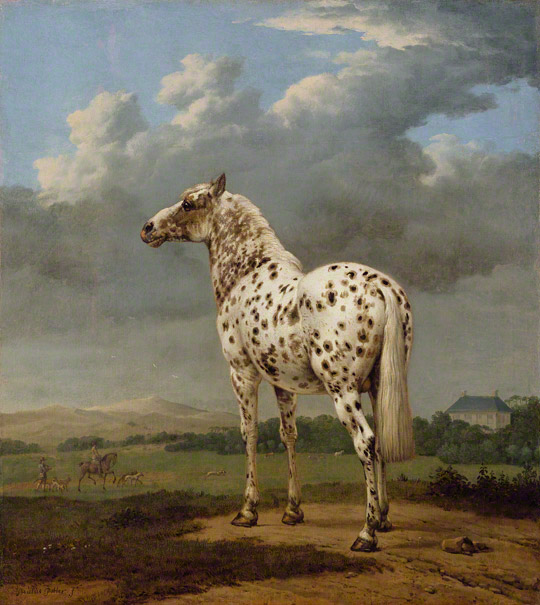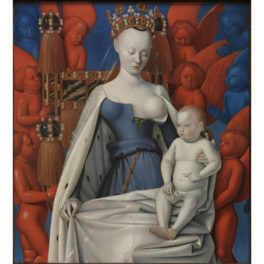
Brood Mares and Foals, George Stubbs, 1767. Oil on canvas, 39 1/4 x 74 1/4 in. Anonymous loan
In George Stubbs’s Brood Mares and Foals, which arrived at the Museum in October as a temporary anonymous loan, horses are sympathetically portrayed within the bucolic landscape of the English countryside.
The overriding mood is idyllic, as a small coterie of well-bred mares and foals congregate harmoniously in the placid atmosphere of the stud farm. When standing before the picture, one is equally struck by the easy manner in which the horses occupy the landscape and by the palpable sense of well-being among the mares and foals.
Rather than a starchy presentation of thoroughbred racehorses accompanied by their jockeys and mutually bedecked in the regalia of their collaborative sporting endeavor, these horses have been portrayed free of the accoutrements of “the turf,” in an unbridled state. In the latter regard, Brood Mares and Foals hits a resonant chord with Paulus Potter’s majestic “Piebald” Horse, which hangs in the Museum’s 17th-century Dutch galleries. Though Potter (1625–1654) and Stubbs (1724–1806) were separated in time and place by a century and the North Sea, the common concern for portraying the horse in nature is especially striking in these two pictures.

The “Piebald” Horse, Paulus Potter, about 1650–54. Oil on canvas, 19 1/2 x 17 11/16 in. The J. Paul Getty Museum, 88.PA.87
While Potter’s drawings and paintings demonstrate that he held a keen ability to depict domesticated animals, Stubbs’s pursuit of anatomical verisimilitude in the case of horses would take the concern to a new level. In 1766, after five years of preparing anatomical studies based on first-hand examination of horse cadavers, Stubbs published his Anatomy of the Horse. The artist’s intricate knowledge of every tendon and ligament, every bone and vein, is evident in the persuasive gracefulness with which each animal is captured in Brood Mares and Foals.
To Stubbs’s mind and that of his patrons (i.e., sporting gentlemen, almost uniformly), the gracefulness and dignity of each horse was contingent upon its pedigree. The thoroughbred horse, as all those portrayed were, had resulted from the crossbreeding of Arabian and Turkish (or Barbary) with English or Spanish horses, at the beginning of the 18th century. Though a hierarchy of lineage—taking into account the ancestry of both stallion and mare—quickly developed and was dutifully recorded in the “Stud books,” the common emphasis for all thoroughbred foals, as they developed, was the much-anticipated realization of stamina, lithe and nimble athleticism, handsome looks, and in the case of stallions, reproductive vigor.

Detail of the white mare with a foal in Stubbs’s Brood Mares and Foals. Anonymous loan
The preoccupation with well-bred horses in England was principally the domain of well-born gentlemen who could afford to devote their time and money to the turf. About 1760, Sir Joshua Reynolds (1723–1792), London’s preferred painter of the peerage in the third quarter of the 18th century, is thought to have introduced Stubbs to a set of wealthy racehorse owners and breeders; for between 1760 and 1767, the artist received seven aristocratic commissions, of which Brood Mares and Foals forms the last.
Judy Egerton, the current expert on the artist, adjudged the picture the finest of all such compositions. The fact that it was the only one of the series to be engraved at the time of its completion is perhaps testimony to its ravishing qualities. Moreover, Stubbs’s personal estimation of Brood Mares and Foals must have been considerable, as he selected the work as his only horse picture in the London Society of Artists exhibition of spring 1768.
The first documented owner of the picture, Colonel George Lane Parker (1724–1791), presumably held it in similar esteem, and Brood Mares and Foals would remain within the Parker family after his death and until its sale at auction in December 2010, more than two centuries later.
Though equine pictures had become fashionable in London townhouses by the mid-18th century, their principal—and de rigueur—function to adorn the entry halls of great country houses appears to have been the context in which Brood Mares and Foals hung resplendently in Parker’s Cambridgeshire home.
In the context of the Museum, it is of special note that Colonel Parker, born in the same year as Stubbs himself, was the younger son of George Parker (c. 1697–1764), 2nd Earl of Macclesfield. The colonel resided at Woodbury, Cambridgeshire, the ancestral family seat of Shirburn Castle, Oxfordshire, having passed to his elder brother Thomas when he succeeded to the earldom upon their father’s death. George Parker, after studying at Clare College and Corpus Christi, Cambridge, had toured Italy from 1719 to 1722, where in Florence he commissioned casts from Pietro Cipriani (c. 1680–c. 1745) of the Venus de’ Medici and Dancing Faun. In 2008, the Museum acquired these sculptures.

Venus de’ Medici (left) and Dancing Faun (right), Pietro Cipriani, 1722–24. Bronze, 61 1/8 in. high (Venus) and 56 1/2 in. high (Faun). The J. Paul Getty Museum, 2008.41.1 and 2008.41.2
While it remains unknown whether Brood Mares and Foals was commissioned by Colonel Parker (as well as whether he bred horses), Egerton has cogently observed that, for the artist’s sporting patrons, “to be content with generalized images [of horses] would have been like hanging portraits of other men’s children on their walls.” They demanded something more personal from the artist. Perhaps, then, Egerton’s salient observation favors the hypothesis that Stubbs was indeed solicited by Colonel Parker to immortalize his own mares and foals, in paint, in the serene surroundings of an idealized farm.

Stubbs’s Brood Mares and Foals hangs in the Getty Center’s South Pavilion, Gallery S202. At right is Pompeo Batoni’s Portrait of John Talbot, later 1st Earl Talbot from the Museum’s permanent collection.




Comments on this post are now closed.